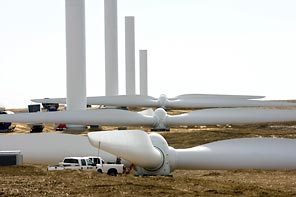forum
library
tutorial
contact

Northwest's Wind Power Could Quadruple
by Gail Kinsey HillThe Oregonian, July 21, 2008
|
the film forum library tutorial contact |

|
Northwest's Wind Power Could Quadrupleby Gail Kinsey HillThe Oregonian, July 21, 2008 |
A BPA assessment shows developers are ready to build wind farms, but power lines can't handle much more
 Utilities and independent developers are poised to more than quadruple the amount of wind power in the Northwest, a huge increase that underscores the region's push for renewable energy.
Utilities and independent developers are poised to more than quadruple the amount of wind power in the Northwest, a huge increase that underscores the region's push for renewable energy.
"It's phenomenal," said Elliot Mainzer, a transmission manager with the federal Bonneville Power Administration. "It's more than we expected."
Evidence of the wind rush shows up in a recent BPA assessment aimed at finding out how much more electricity will fit on transmission lines that deliver to customers in urban centers such as Portland and Seattle.
Though the tally shows a wholehearted embrace of clean, renewable energy, it also exposes the limits of the transmission network, or grid. Unless more power lines are added, the Northwest won't be able to handle so much wind so quickly, the BPA said.
The BPA said it has space on the grid to add only one-third of the 4,716 anticipated megawatts.
"A resource isn't very valuable unless you can deliver it," Mainzer said.
The study also showed that almost 30 percent of the additional power could head across Oregon's southern border, where California utilities aggressively snap up renewable energy produced throughout the West.
The Columbia River Gorge is home to most of the Northwest's wind farms, with thousands of turbines stretching from Sherman County east to the border. Most of those projects hook into the BPA's transmission network, delivering power to customers in Oregon, Washington, California and Idaho.
Currently, the system handles about 1,490 megawatts of wind capacity, a number expected to rise to 2,000 megawatts by year's end. That's enough power to meet the annual electricity requirements of about 500,000 homes.
The BPA analysis shows developers eager to add 4,716 megawatts to the lineup in as little as five years, bringing wind power production to four times its current level.
Even wind power advocates were startled by the numbers.
"It's an incredibly robust response . . . a welcome surprise," said Rachel Shimshak, director of Renewable Northwest Project, a Portland-based group that promotes clean energy such as wind, solar and geothermal.
Several big players emerged from the assessment: Columbia Energy Partners, a Vancouver company with sights on a huge project in Harney County's Steens Mountain; Iberdrola Renewables, formerly PPM Energy, an international wind developer that boasts a hefty presence in the gorge; and Horizon Wind Energy, which wants to build a series of large wind farms near La Grande.
The Steens Mountain project could involve as much as 800 megawatts and, for the first time, bring Harney County into the region's wind mix. It also could run into controversy from birders, hikers and vacationers who seek out the area in the summer months.
Further, it would need miles of transmission lines to connect it to the BPA's main network.
Plans backed with cash
These are not pie-in-the-sky proposals. Developers had to back up their requests for transmission access with cash -- $1.56 million for every 100 megawatts they wanted to put on the grid.
"Those who sign and pay, stay in the game," Mainzer said. "The rest are dropped from the queue."
The BPA began the process in mid-April, intent on getting a firm grip on the wind energy it would need to blend into the grid.
Under the prior policy, developers could sign up for transmission access at any time, first come, first served, with no security deposit required. The result: a deluge of requests with no way for the BPA to tell when, or if, the projects would be built.
"The sheer number of requests brought the queuing process to a complete standstill," Mainzer said.
The new approach, with its stricter upfront requirements, winnows out the iffy requests. And it allows the BPA to study the projects in clusters to determine when new transmission might be needed, where and at what cost.
Currently, developers share the expense of transmission improvements, but as projects stretch into more remote areas, costs will rise and conflicts could develop.
Stringing lines from the BPA's network to new wind farms costs an estimated $1 million to $3 million a mile.
"One of the thorniest, trickiest issues is cost allocation," Mainzer said.
Independent developers such as Iberdrola, Horizon, Columbia Energy Partners and enXco account for the bulk of the requests.
The rest come from utilities, primarily Washington's Puget Sound Energy and Snohomish Public Utility District. PacifiCorp has requested a small amount of transmission access, and Portland General Electric none at all.
Laws require renewables
New energy laws in Oregon and Washington require the states' large utilities to significantly increase the amount of renewable energy they deliver to customers. Oregon's is the most aggressive, with a requirement that renewable energy accounts for 15 percent of electricity supplies by 2015 and 25 percent by 2025.
At this point, about 4 percent of the electricity used by Oregon consumers comes from renewables, most of which is wind.
Utilities can either build the facilities themselves or buy the power from independent power producers, such as Iberdrola or Horizon.
California's renewables requirement is stricter still, calling on utilities to get 20 percent of their electricity from wind, solar and other sources by 2010.
Already, the state is buying wind power from Oregon and Washington. The BPA assessment, which shows deliveries of 1,350 megawatts to the California-Oregon border, suggests considerably more purchases in the years ahead.
Wind energy advocates in the Northwest say they're encouraged by the amount of wind power that has stayed in the area. They say they're confident Oregon and Washington can meet their upcoming quotas. A total of 6,000 megawatts of wind would supply about 8 percent of the Northwest's electricity needs, according to a BPA report.
"This should put the complaints to rest," said Shimshak of the Renewable Northwest Project.
Yet, a stressed transmission system isn't the only obstacle.
The BPA regulates the turbines at the Columbia River's hydroelectric dams to smooth out wind power's variability as it enters the grid. But, other requirements -- for fish and flood control -- limit flexibility. More wind will demand better planning strategies, the BPA and developers say.
"It's absolutely essential that broader coordination will be needed to accommodate this type of wind," Mainzer said.
learn more on topics covered in the film
see the video
read the script
learn the songs
discussion forum
